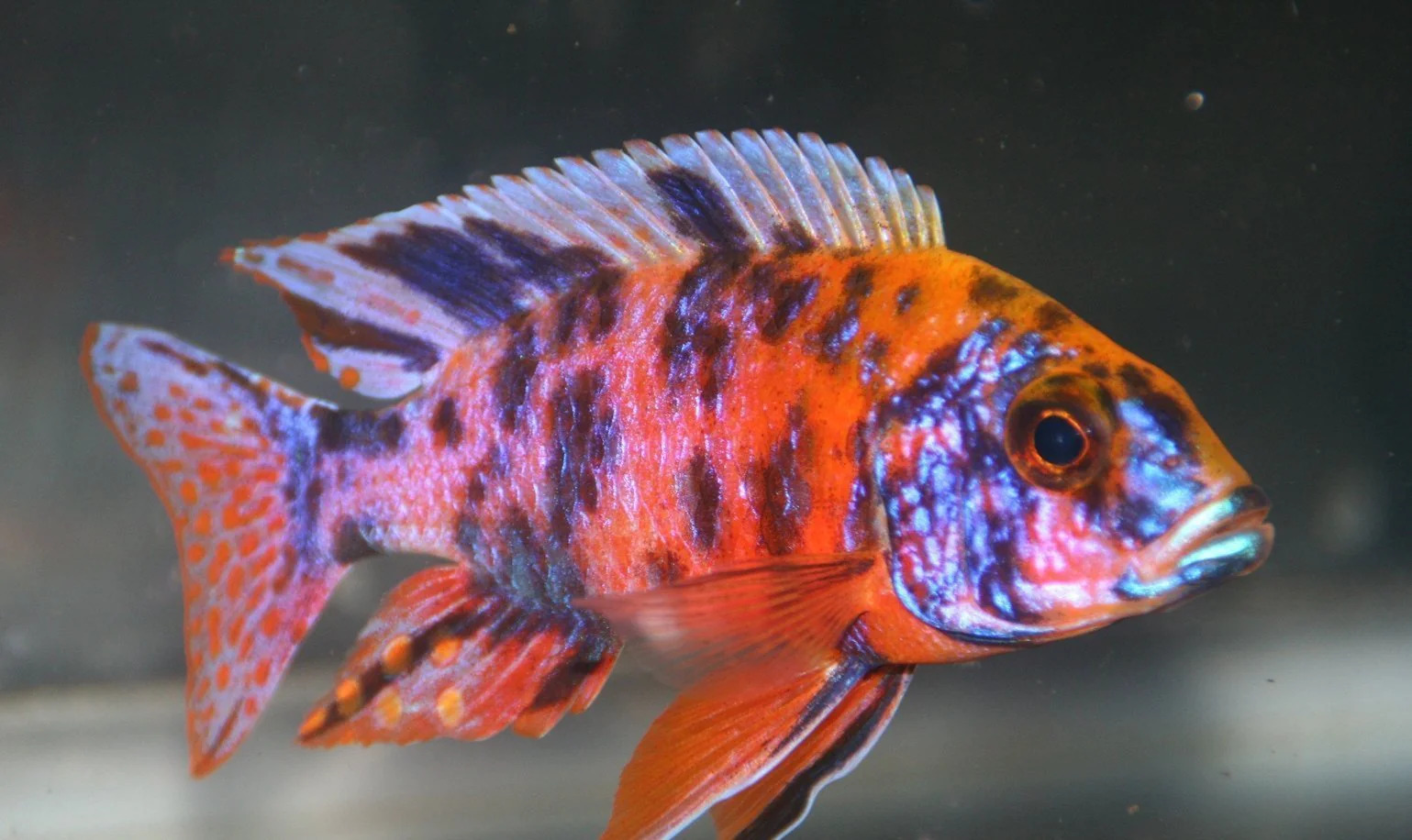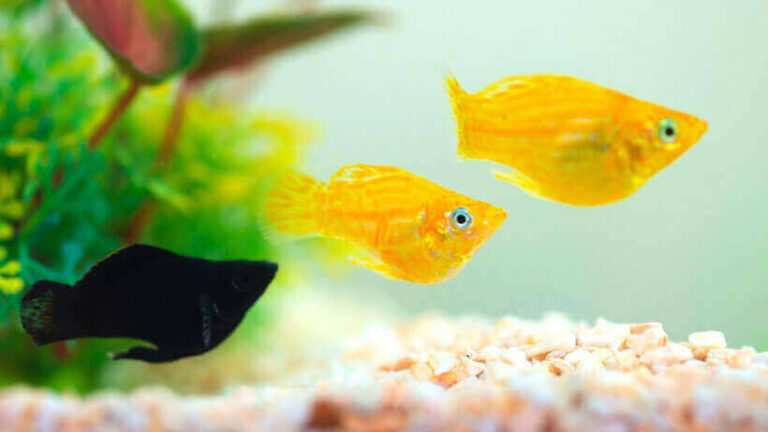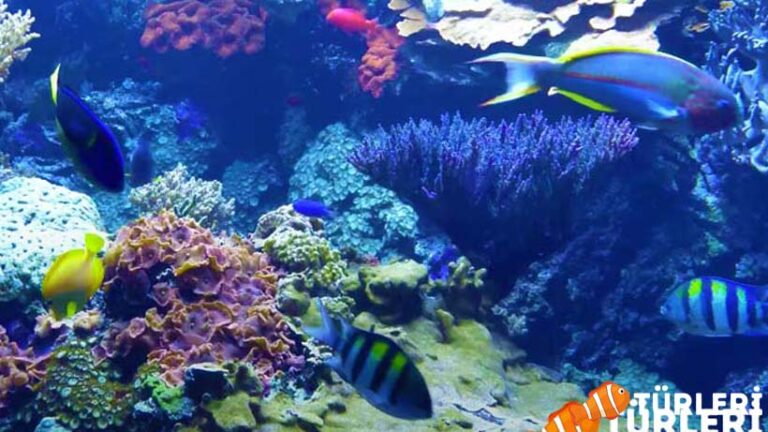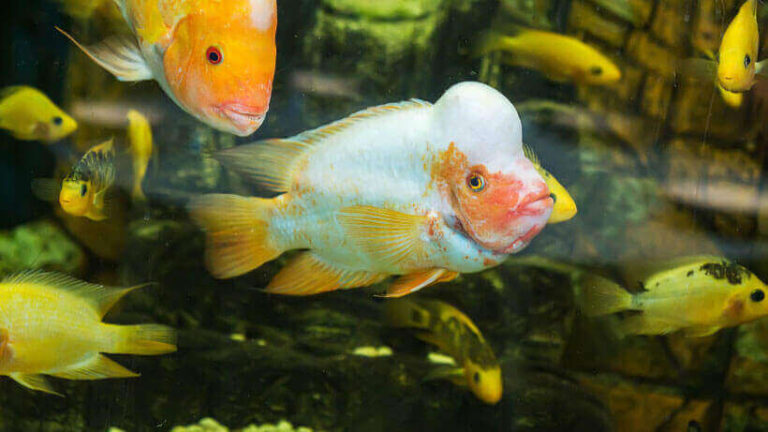Peacock Cichlid
Peacock Cichlids are a popular choice among aquarium enthusiasts due to their vibrant colors and relatively peaceful nature. They belong to the genus Aulonocara and are native to Lake Malawi in Africa. There are several types of Peacock Cichlids, each with its unique coloration. Here’s a 101 guide to their care, types, tank mates, and more.
Peacock Cichlid Fish Species Summary:
| Scientific Name: | Aulonocara sp. |
| Origin: | Freshwater lakes of East Africa, predominantly Lake Malawi |
| Diet: | Omnivore (feeds on a variety of foods including small crustaceans, insects, and plankton) |
| Behavior: | Generally peaceful but can show aggression during breeding season or if space is limited |
| Behavior Towards Their Own Species: | Males can be territorial and aggressive towards other males, especially during breeding season. Sufficient hiding spots should be provided to minimize aggression. |
| Swimming Zone: | Middle to bottom |
| Water Temperature: | 24 – 28 °C |
| Water Hardness: | 10 – 20 GH |
| pH Level: | 7.8 – 8.6 |
| Minimum Aquarium Volume: | 200 Liters (can vary depending on the number of individuals) |
| Adult Size: | 10 – 15 cm (can vary among species) |
| Reproduction: | Mouthbrooders. Females carry the eggs in their mouth until they hatch. |
| Lifespan: | 5 – 10 years (with proper care) |
| Care: | Moderate, requires regular aquarium cleaning and monitoring of water parameters. Provide plenty of hiding spaces and a well-balanced diet. |
Tank Size Considerations
When it comes to aquarium fish, the Peacock Cichlid is relatively modest in its requirements, but like all fish, it will thrive best when given ample space. A 30-gallon tank is indeed the minimum size recommended for a single Peacock Cichlid, as it provides enough space for the fish to swim, explore, and establish its territory. However, this size is strictly for one individual. Peacock Cichlids are active and colorful fish that can grow up to 6 inches (15 cm) in length, and a 30-gallon tank may quickly become too cramped if more fish are added.
Community and Multiple Fish
If you are planning on keeping more than one Peacock Cichlid, or a community of different species, a larger tank is essential. It is recommended to add an extra 20-30 gallons of water for each additional Peacock Cichlid. For example, if you are planning on keeping three Peacock Cichlids, a 70 to 90-gallon tank would be more appropriate. This will help reduce stress among the fish, minimize aggression, and provide enough space for each fish to establish its own territory.
Moreover, if you are considering keeping a mixed species community, you need to be even more careful with tank size. While Peacock Cichlids are relatively peaceful, they can show aggression towards smaller fish, and they may not be compatible with all species. Therefore, having a larger tank can help diffuse aggression and ensure that there are plenty of hiding spots for all inhabitants.
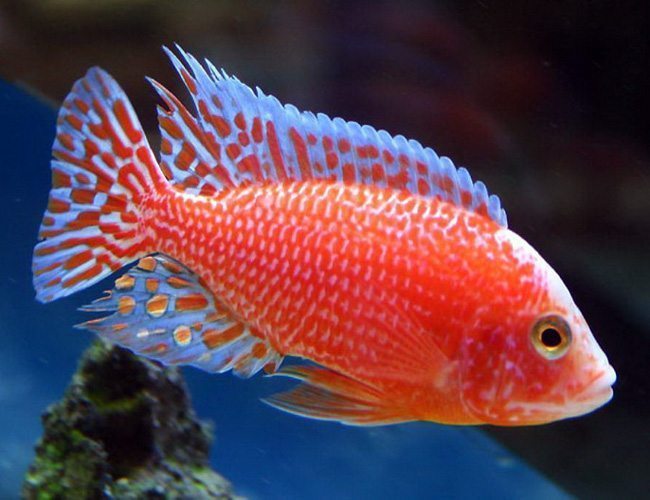
Water Parameters and Decorations
Apart from the tank size, it is also important to consider other aspects of the tank environment. Peacock Cichlids are native to the rocky shores of Lake Malawi in Africa, and they prefer a pH of 7.8-8.6, and a water temperature of 76-82°F (24-28°C). Therefore, it is important to closely monitor and maintain the water parameters in the tank.
Additionally, decorating the tank with rocks and caves will not only make it more visually appealing but will also provide the Peacock Cichlids with places to hide and establish territories. This is particularly important in a community tank, as it will help reduce stress and aggression among the fish.
While a 30-gallon tank is the minimum recommended size for a single Peacock Cichlid, it is always better to opt for a larger tank, especially if you plan on keeping more than one fish or a mixed species community. A larger tank will reduce stress, minimize aggression, and provide a healthier and more natural environment for the fish. Remember to also consider other important aspects of the tank environment, such as water parameters and decorations, to ensure the well-being of your Peacock Cichlids.
Water Parameters
Peacock Cichlids thrive in slightly alkaline water, which is why it’s crucial to maintain the pH level between 7.8 and 8.6. This pH range is optimal for their health and well-being. Additionally, the water temperature should be kept between 76°F and 82°F (24°C – 28°C). This temperature range is close to the natural habitat temperature of Lake Malawi, where Peacock Cichlids are found. Maintaining these water parameters will help keep the Peacock Cichlids healthy and stress-free. It’s essential to regularly test the water parameters using a water testing kit to ensure that the pH and temperature are within the recommended range.
Filtration
A high-quality filtration system is essential for keeping Peacock Cichlids healthy. The filtration system will help remove waste products, excess food, and debris from the water, maintaining good water quality. There are three types of filtration: mechanical, chemical, and biological. A good filter will incorporate all three. Mechanical filtration removes solid particles, chemical filtration removes harmful chemicals, and biological filtration breaks down toxic ammonia and nitrite into less harmful nitrate. Peacock Cichlids produce a moderate amount of waste, so a powerful filter is necessary to keep the water clean and clear.
Substrate and Decor
The substrate and decor in the aquarium play a crucial role in making the Peacock Cichlids feel at home. A substrate of fine sand is recommended as it closely resembles their natural habitat in Lake Malawi. Moreover, decorating the tank with rocks and caves will provide hiding spots and territories for the Peacock Cichlids. However, it is important to avoid sharp objects or decorations that can harm the fish. Smooth river rocks or specially designed aquarium decorations are ideal. Arrange the rocks and caves in a way that creates multiple hiding spots and territories, but also allows open swimming spaces. This will help reduce stress and aggression among the fish and create a more natural and comfortable environment.
Diet
Peacock Cichlids are omnivores, which means they eat both plant and animal matter. It is essential to provide a balanced diet to keep them healthy and vibrant. High-quality cichlid pellets and flakes should form the base of their diet as they are specifically formulated to meet the nutritional needs of cichlids. However, a diet solely based on pellets and flakes may not provide all the essential nutrients. Therefore, it is important to supplement their diet with occasional treats of live or frozen foods like brine shrimp, bloodworms, and vegetables such as spinach or zucchini.
Live foods are particularly beneficial as they not only provide essential nutrients but also encourage natural hunting behaviors. However, care should be taken not to overfeed live foods as they can increase the risk of disease. Frozen foods are a safer alternative as they are usually free from parasites and pathogens. Vegetables provide essential fibers that aid in digestion. It is recommended to feed Peacock Cichlids twice a day, offering only as much food as they can consume in a few minutes. Overfeeding can lead to obesity and water pollution, both of which can be detrimental to the fish’s health.
Lighting
Lighting plays a crucial role in the well-being of Peacock Cichlids. Moderate lighting is recommended as it creates a comfortable environment for the fish and enhances their natural colors. Too bright light can stress the fish as it does not mimic their natural habitat, and too dim light can dull their colors and affect their behavior.
It is important to provide a consistent light cycle that mimics the natural day and night cycle. A timer can be used to turn the lights on and off at the same time each day. Additionally, providing some shaded areas in the tank using plants or decorations can help create a more natural environment and provide refuge for the fish if the light becomes too intense.
Maintenance
Regular maintenance is essential to keep the aquarium environment healthy for the Peacock Cichlids. At a minimum, it is recommended to change 20-30% of the water at least once every two weeks. However, more frequent water changes may be necessary depending on the tank size, number of fish, and efficiency of the filtration system. It is essential to test the water parameters frequently, especially in a new setup, to ensure that the pH, temperature, and nitrate levels are within the recommended range.
Additionally, the filter media should be cleaned or replaced as per the manufacturer’s instructions. Over time, the filter media can become clogged with debris and lose its effectiveness. However, it is important not to clean all the filter media at once as it contains beneficial bacteria that help break down waste products. Instead, it is recommended to clean or replace one-third of the filter media every month.
Furthermore, the substrate should be vacuumed regularly to remove debris and uneaten food. Decorations and plants should also be cleaned to remove algae and other organic matter. However, it is important not to use soap or any chemical cleaners as they can be toxic to the fish.
It is also recommended to inspect the fish regularly for any signs of disease or stress. Common signs of stress include rapid gill movement, loss of color, and erratic behavior. If any of these signs are observed, it is important to address the underlying cause promptly.
Peacock Cichlids are beautiful and relatively easy-to-care-for fish that can be a great addition to any aquarium. However, like all fish, they have specific requirements that need to be met to keep them healthy and happy. A balanced diet, moderate lighting, and regular maintenance are essential to provide a suitable environment for Peacock Cichlids. Additionally, it is important to provide adequate space, maintain proper water parameters, and provide suitable tank mates to ensure their well-being. By paying attention to these details and providing proper care, Peacock Cichlids can thrive and bring beauty and vitality to any aquarium.
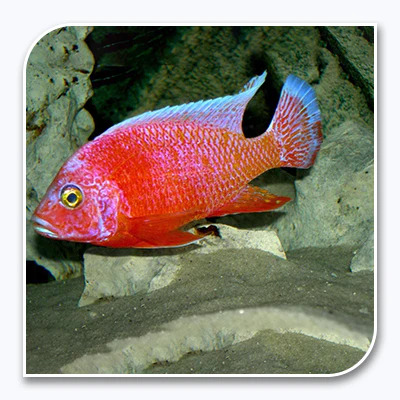
Species
There are over 20 species of Peacock Cichlids, each with its unique coloring. Some popular species include:
- Blue Peacock Cichlid (Aulonocara nyassae): This is one of the most popular species where the males display vibrant blue colors.
- Red Peacock Cichlid: The males of this species exhibit bright red-orange coloring.
- Yellow Peacock Cichlid: This species displays bright yellow coloring.
- Sunshine Peacock (Aulonocara stuartgranti): This species displays a bright yellow body with blue highlights.
- Flavescent Peacock (Aulonocara stuartgranti ‘maleri’): This species displays a light blue-white body with dark blue markings.
Peacock Cichlids are known for their stunning colors, especially the males. The females of most species are usually less colorful, often displaying a silver or brownish hue. The different colors and patterns make each species unique and highly sought after by aquarium enthusiasts.
Habitat and Distribution
Peacock Cichlids are endemic to Lake Malawi in East Africa, one of the largest freshwater lakes in the world. The lake is home to a vast number of cichlid species, many of which are found nowhere else on Earth. Peacock Cichlids are found in various habitats within the lake, from rocky shorelines to sandy bottoms and deep waters.
Behavior and Social Structure
Peacock Cichlids are generally peaceful and can get along well with other non-aggressive species. However, males can be territorial, especially during the breeding season. It is advisable to provide plenty of hiding spots and territorial markers like rocks and caves in the aquarium to minimize aggression. A larger tank is also recommended to give each fish enough space to establish its territory.
Tank Mates
Peacock Cichlids can be kept with other non-aggressive species of a similar size. Other species of cichlids from Lake Malawi, such as the Mbuna, can be suitable tank mates. However, it is advisable to avoid mixing them with fish that have a similar coloration or pattern as this can lead to aggression. Also, it is recommended to keep a higher ratio of females to males to minimize aggression.
Peacock Cichlids are a stunning addition to any aquarium. Their vibrant colors and relatively peaceful nature make them a popular choice among aquarium enthusiasts. Proper care, including a balanced diet, appropriate tank setup, and regular maintenance, is essential for their health and well-being. Providing the right conditions can ensure that Peacock Cichlids thrive and bring beauty and vitality to any aquarium.
- Other Peacock Cichlids: Different species of Peacock Cichlids can usually coexist peacefully in the same tank. However, it is recommended to keep only one male of each species to avoid hybridization and aggression. Hybridization can lead to offspring that do not possess the same vibrant colors as their parents, while having multiple males can lead to territorial disputes and stress for the fish.
- Yellow Labs (Labidochromis caeruleus): Yellow Labs are a type of cichlid that are known for their non-aggressive nature. They are characterized by their bright yellow bodies and black fins. Yellow Labs are native to Lake Malawi, like Peacock Cichlids, and they share similar water parameter requirements. This makes them an excellent tank mate for Peacock Cichlids.
- Acei Cichlid (Pseudotropheus acei): Acei Cichlids are another species of cichlid that are known for their non-aggressive behavior. They are characterized by their blue bodies with yellow fins. Like Peacock Cichlids, Acei Cichlids are also native to Lake Malawi and have similar water parameter requirements, making them another suitable tank mate.
- Rainbowfish: Most species of Rainbowfish are peaceful and can coexist well with Peacock Cichlids. Rainbowfish are characterized by their colorful bodies and are native to Australia, Papua New Guinea, and Indonesia. They prefer slightly acidic to neutral water, so it is important to monitor the water parameters to ensure they are suitable for both Rainbowfish and Peacock Cichlids.
- Catfish: Most species of catfish, like Corydoras and Plecos, are peaceful bottom dwellers that can coexist well with Peacock Cichlids. Corydoras catfish are characterized by their armored bodies and are native to South America. Plecos are characterized by their flat bodies and sucker mouths and are also native to South America. Both Corydoras and Plecos prefer slightly acidic to neutral water, so again, it is important to monitor the water parameters to ensure they are suitable for both catfish and Peacock Cichlids.
Note: It is important to avoid keeping Peacock Cichlids with aggressive or fin-nipping species. Aggressive species can cause stress and harm to Peacock Cichlids, while fin-nipping species can cause damage to their fins. It is also important to provide plenty of hiding spots and territorial markers like rocks and caves in the aquarium to minimize aggression.
Breeding Peacock Cichlids

Sexing Peacock Cichlids
Determining the sex of Peacock Cichlids can be a bit challenging, especially when they are young. However, as they mature, males typically become more colorful and slightly larger than females. Males exhibit vibrant hues of blue, yellow, or orange, while females often remain duller and may have brown or grey coloration. Although there is some variation in color between different species of Peacock Cichlids, the males are generally more colorful across all species.
Breeding Tank Setup
Setting up a separate breeding tank is essential for the successful breeding of Peacock Cichlids. The breeding tank should be at least 40-50 gallons to provide enough space for the pair. It is crucial to provide plenty of hiding spots in the breeding tank, as this will make the female feel safe and secure. Smooth rocks, caves, and dense vegetation can be used to create hiding spots. A smooth substrate, such as fine sand, should be used to prevent injury to the female when she picks up the eggs.
Water parameters should be closely monitored and maintained within the appropriate range for Peacock Cichlids: pH between 7.8-8.6, temperature between 76-82°F (24-28°C), and hardness between 10-20 dGH. Good water quality is essential for successful breeding, so a high-quality filter and regular water changes are necessary.
Spawning Behavior
Peacock Cichlids are mouthbrooders, which means the female will carry the eggs in her mouth until they hatch. The spawning process usually begins with the male displaying his vibrant colors and performing a courtship dance to attract the female. Once the female is ready, she will lay a small batch of eggs, usually between 10-50, on a smooth surface. She will then quickly pick up the eggs in her mouth.
The male has specialized spots on his anal fin that resemble eggs. The female, attempting to collect these “eggs,” will nudge the male’s anal fin, at which point he will release sperm that will fertilize the real eggs in the female’s mouth. This unique fertilization process is known as “egg-spot fertilization.”
Incubation Period
The female will carry the fertilized eggs in her mouth for about 21-28 days until they hatch. During this incubation period, the female will not eat and may hide more than usual to avoid potential threats. It is essential to provide a stress-free environment for the female during this time, as stress can lead to the female spitting out the eggs or fry prematurely.
Fry Care
Once the fry are released by the female, they can be fed finely crushed flakes or specially formulated fry food. It is essential to provide plenty of hiding spots for the fry to avoid predation by the adults. Live plants, small caves, and rocky crevices work well as hiding spots.
The fry will grow quickly with proper care and feeding. It is crucial to maintain good water quality in the fry tank by performing regular water changes and using a high-quality filter. As the fry grow larger, they can be gradually introduced to a diet of larger flakes, pellets, and eventually, live or frozen foods like brine shrimp and bloodworms.
Breeding Peacock Cichlids requires careful planning and attention to detail. It is essential to set up a separate breeding tank with plenty of hiding spots and a smooth substrate. The water parameters should be closely monitored and maintained within the appropriate range. The unique spawning behavior of Peacock Cichlids involves the female carrying the fertilized eggs in her mouth for about 21-28 days until they hatch. Proper care of the fry involves providing plenty of hiding spots and a diet of finely crushed flakes or specially formulated fry food. With commitment and responsibility, breeding Peacock Cichlids can be a rewarding and fascinating experience. Remember, caring for Peacock Cichlids or any other fish requires a high level of commitment and responsibility. Ensure you have the time, resources, and knowledge to provide proper care for your fish before deciding to keep them.
Other Factors to Consider
- Tank Size: The size of the tank is an important factor to consider when choosing tank mates for Peacock Cichlids. A larger tank can help to reduce territorial disputes and provide enough space for all the fish to establish their territories. A minimum tank size of 55 gallons is recommended for keeping Peacock Cichlids with other fish.
- Water Parameters: It is important to maintain the water parameters within the suitable range for all the fish in the tank. Regular water changes and a good filtration system are essential to maintain water quality.
- Diet: Different fish have different dietary requirements. It is important to provide a balanced diet that meets the nutritional needs of all the fish in the tank. Peacock Cichlids are omnivorous and require a diet that includes both plant and animal matter. A high-quality cichlid pellet or flake food, supplemented with occasional treats of live or frozen foods like brine shrimp and bloodworms, and vegetables like spinach and zucchini, is recommended.
- Sex Ratio: It is recommended to keep a higher ratio of females to males to minimize aggression. For example, a ratio of one male to three or four females is recommended.
- Observation: It is important to regularly observe the fish for any signs of stress or aggression. If any fish is being bullied or is showing signs of stress, it may be necessary to separate them or rearrange the tank to provide more hiding spots.
Peacock Cichlids are a stunning addition to any aquarium and can be kept with a variety of other fish species. However, it is important to carefully consider the tank mates, as Peacock Cichlids can be territorial, especially during breeding times. Suitable tank mates include other Peacock Cichlids, Yellow Labs, Acei Cichlids, Rainbowfish, and catfish like Corydoras and Plecos. It is important to provide a large enough tank, maintain the water parameters within the suitable range, provide a balanced diet, and regularly observe the fish for any signs of stress or aggression. With proper care and consideration, Peacock Cichlids can thrive and bring beauty and vitality to any aquarium.

